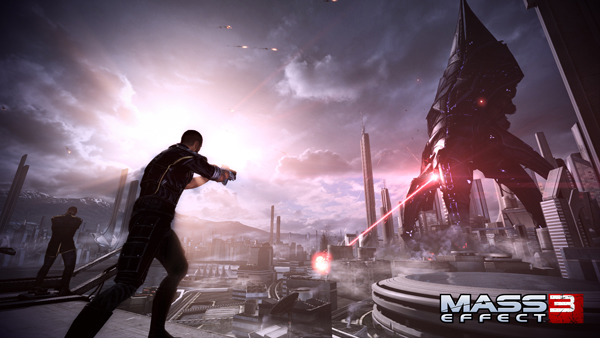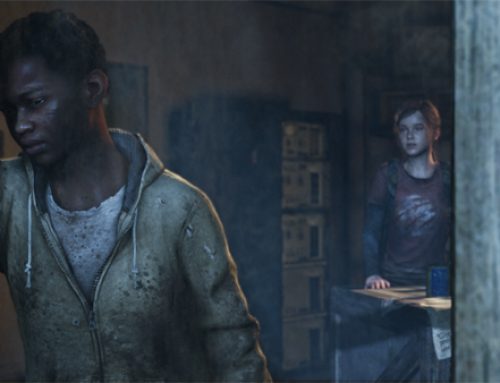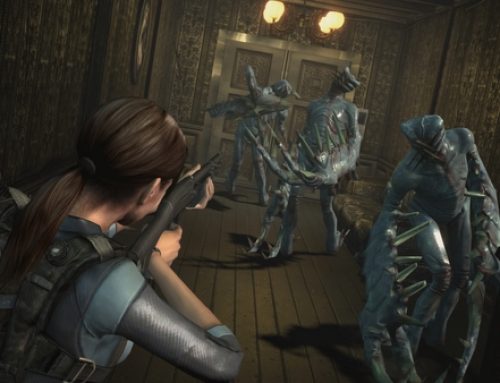
"Mass Effect 3" opens with an assault on Earth by the Reapers, a synthetic species bent on wiping out advanced organic life.
Blogger’s note: My “Mass Effect 3” review ran in the April 6 Press Democrat, but I held it back for publication on the blog so that I could add a few more thoughts.
Since “Mass Effect 3” released last month, it’s been hard to escape the firestorm over the disappointing way BioWare ended its epic trilogy. But to fixate on the galaxy’s murky fate, the final five minutes of mystical mumbo jumbo and the fact that, in the end, the choices we players made didn’t make that much of a difference, is to lose sight of what the trilogy does well.
Over five years, three games, numerous downloadable add-ons and supplementary materials like comics, novels and iPad apps, BioWare has created arguably the deepest, most well thought-out sci-fi universe since “Star Wars” and “Star Trek.”
Commander Shepard’s push to unite a coalition of alien races against an ancient robotic civilization bent on wiping out all advanced organic life teems with compelling plot lines, weighty dilemmas and gameplay that lets Shepard hurl enemies through the air with his mind or blast them apart with all manner of exotic weaponry.
That gameplay is polished in “Mass Effect 3.” While “Mass Effect 2” [review] often felt like an awkward attempt to switch the series from a tactical, deeply customizable role-playing game to an action-oriented shooter that appealed to fans of games like “Gears of War,” “ME3” feels comfortable in its own skin.
The level design, while basic, feels more inspired than “Mass Effect 2’s,” and choosing your squad’s arsenal is more complicated than just going with the last gun you acquired because it’s better than what you had before. In this respect, customizing your weaponry is a Goldilocksian balance between the first game’s cornucopia of sameness and “ME2’s” almost comic overcorrection.
The gameplay is good enough not to get in the way of the series’ main strength: its characters, whose development is steered in part through players’ choices.
The squadmates who stand at Shepard’s side in all three games, as well as such secondary personalities as Galactic Council members and the crew of the SSV Normandy, make the hostile “Mass Effect” universe familiar and comforting. Even Shepard superfan Conrad Verner is a welcome sight.
By importing decisions made by players in previous “Mass Effect” offerings, “ME3” provides the greatest type of fan service, packing in plenty of hidden surprises, startling developments and seemingly innocent lines of dialogue freighted with hidden meaning.
The enjoyable journey makes up for the lackluster ending. While some players have bristled at the game’s limited number of final outcomes, it’s best to look at “Mass Effect 3” as being like a road trip. Two people could start and end at the same places, but they’ll chose to visit different landmarks, talk to different locals and set different priorities.
As a result of the “Mass Effect” series’ unprecedented game-to-game continuity, video gamers finally have our “Star Wars” or “Lord of the Rings” trilogy — a series we can binge on, playing through from start to finish, noting how one character’s premature death closes off or opens up later story lines. After finishing “Mass Effect 3,” I’ve been tempted to start the whole series over so that I can see the development arc of characters I lost in the first and second games.
“ME3’s” carryover of data is occasionally inelegant. In one instance Kasumi, a downloadable character from “Mass Effect 2,” referenced having been on that game’s climactic suicide mission, even though I had not yet recruited Kasumi at the time I ran that mission in the earlier game.
Another key “Mass Effect 2” character failed to appear in my game at all, though his death was referenced in dialogue near the end of “Mass Effect 3.”
The most egregious carryover sin is a well-publicized glitch that prevents players who customized Shepard’s face in the first “Mass Effect” from importing his appearance into this year’s game. After more than 100 hours of play time over two games with my original Shepard, it was a bummer to have to redo his face for the conclusion of the trilogy. It seems like a pretty basic thing for BioWare to have screwed up, but those picking up the game later will most likely not have to deal with the problem. A downloadable fix was released earlier this week, but it has reportedly been causing numerous other issues.
An optional online multiplayer mode, a first for the series, is a heck of a lot of fun but feels quite unbalanced. Certain classes feel much better suited for wiping out waves of computer-controlled enemies. Luckily, because the only multiplayer modes are humans-vs.-computer, class balancing isn’t terribly crucial. “ME3’s” multiplayer is a fun diversion for fans of horde/survival-type games, but I doubt it’s the kind of thing we’ll be coming back to six months from now. With the role multiplayer has in determining your “galactic readiness” in the single-player game, chances are you’ll be able to find people to play with for a while.
“Mass Effect 3,” rated M, costs $60 on the PC, Xbox 360 and PlayStation 3. For this review, I played an Xbox 360 copy of the game provided by the publisher and imported Dirk Shepard, the paragon adept I used in the first two “Mass Effect” games.
Addendum: You’ve probably noticed this blog is being updated less frequently. I’ve taken on some new duties at The Press Democrat, which has left me with less time to play and write about video games. For the time being, my column is running on the first Friday of each month. I hope to supplement with additional blog posts and perhaps up my writing frequency as time allows. Thanks for reading!
Follow Eric on Twitter or join the “GameWit blog” group on Facebook.



